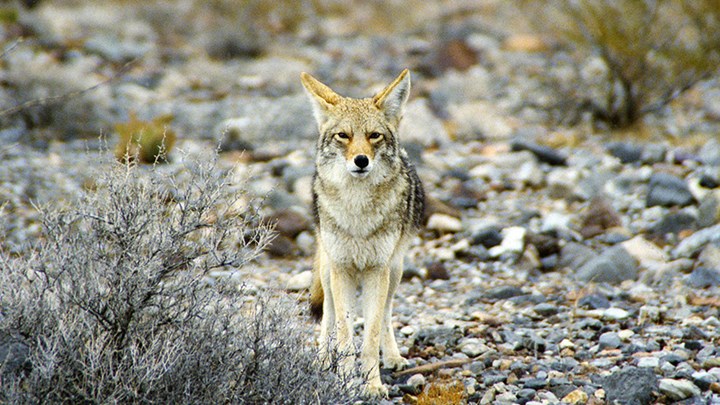
by Ron Spomer - Sunday, February 10, 2019

We were in Florida on a fishing adventure when a cold front moved in, sending every snook and baby tarpon into suspended animation.
“Want to hunt for coyotes instead?” Ana Banana Fishing Company guide Joel Brandenburg asked.
Coyotes? Around Tampa Bay, Fla.?
Oh yes. We bagged one the next morning in a farmer’s backyard. Native to western North America, the little “prairie wolf” has in recent decades crossed the Mississippi and spread widely to become a major invasive species pest, upsetting the predator/prey balance from Maine to Miami. With no larger predators like wolves to control their numbers, coyotes run rampant— unless hunters step up.
Winter is coyote season, that time of year when most other hunts are wrapped and in the freezer. It’s a great hunt for honing skills and introducing new hunters to the excitement of game up close and personal. Snow time is go time (maybe not in Florida) for reducing predatory pressure on deer while collecting all-natural, free-range, biodegradable and sustainable pelts. All you need are a few basic pieces of gear.
I say “basic” because too many coyote hunters complicate what is a simple program: Spot and stalk or call and shoot a cautious, prolific, almost ubiquitous 20- to 45-pound canine predator. Deer hunting rifles, scopes and ammo are more than adequate for the job. In many habitats, so are 12-gauge shotguns. But if you want what many veteran coyote catchers consider the ultimate tool for this job, get a 22-250 Remington. This hot little number pushes a 55-grain bullet 3,650 fps from most 22-inch sporting barrels without pushing your shoulder enough to crack an egg—just 6.4 foot-pounds of recoil in an 8-pound rifle.
Zero that 55-grain bullet 1.5 inches high at 100 yards and trajectory peaks about 2 inches high at 150 yards. Aim for the center of Mr. Coyote’s chest and that screaming little projectile won’t drop below the vital zone until 300 yards. You can pretty much aim dead center from the muzzle to 300 yards. How much easier can it get?
You don’t need to go overboard on scopes, either. A 2-8x36, 3-9x40 or 4-12x44 will more than suffice. Most of your shots will be at 200 yards or closer. With the 22-250’s flat trajectory you won’t need dialing turrets or hold-over sub reticles, either. Keeps things simple when three coyotes are racing in to your calls and your brain is a bowl of jumbled mush. All you have to think is “aim, steady and don’t flinch.”
Most coyotes hit in the chest with a 22-250 Remington collapse right there, but a few will make a death run just like whitetails sometimes do. No big deal. Watch where they go and follow up. If you can’t find a blood trail, do the traditional circle search, fanning out in an arc. Most will expire inside of 50 yards.
Frangible varmint bullets neatly centered on the coyote should stay inside the body cavity, creating maximum internal hemorrhaging, but many will exit, opening a hole in the pelt. Fear not. Holes can rather easily be sewn closed, maintaining good value in the fur.
A binocular isn’t mandatory for coyote hunting, but it adds a lot to your enjoyment. Use one to scan surrounding cover before leaving a calling site. Watch for prominent white patches, the pale throat/chest of a coyote facing you. Don’t scan with the binocular while actively calling. Coyotes seemingly can pop out of nowhere and rush in so fast that you’ll miss them while examining barren ground far away at 10X. Just keep your eyes steadily scanning the landscape for any flicker of movement. And don’t be surprised if your quarry suddenly materializes.
Calling coyotes is as simple as imitating their howls or, easiest of all, screaming like a wounded prey animal. This is no more complicated than crying like a baby. Gruesome as that sounds, it’s accurate, for a human baby’s cry is quite like the wails of cottontails, jackrabbits, fawns and similar coyote prey. If you can make these cries with your voice, you’re set, but a mouth-blown reed call should give you more volume. Electronic callers are easier still, but they cost more and require batteries. FOXPRO sells models that allow up to 1,000 calls to be stored and accessed in an easily transported device.
Regardless what you call with, don’t fret about doing it wrong. There is no right or wrong. Calling success is more about location than the sound itself. Slip into position with a good view of coyote country without letting the residents hear, see or smell you. Then cry and get ready. Many a time we’ve seen coyotes pop out of their beds at less than 100 yards. Other times they seem to come from a mile away. Figure to invest 10 to 30 minutes per calling setup. The later in the season, the longer it takes for coyotes to respond.
By the way, keep your scope set in the 4X to 6X range in case a candidate for your 22-250 hops in your lap. You can always turn up the power if one hangs up at long range. Camo isn’t mandatory, but it sure helps. Most critical is keeping movement to a minimum. Coyotes catch motion quickly, and even if they can’t identify you sitting against that bush or tree, they could hang up and eventually slink away out of sight. Wait until they’re behind a screen of brush or dip in the landscape before shifting into shooting position. Then follow them in your scope, moving slowly and steadily until they present a good shot.
Try to NOT hyperventilate. The thrill of a coyote charging in to dinner can do that to you.
E-mail your comments/questions about this site to:
[email protected]
Proudly supported by The NRA Foundation and Friends of NRA fundraising.
